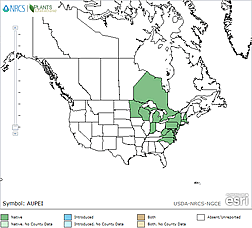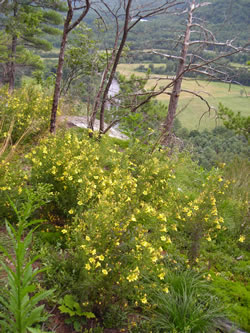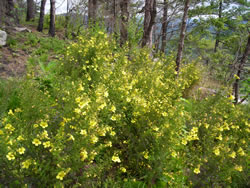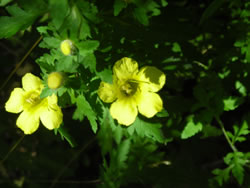Plant of the Week
 Aureolaria pedicularia var. intercedens range map. USDA PLANTS Database.
Aureolaria pedicularia var. intercedens range map. USDA PLANTS Database.
 Fern-leaved false foxglove mass in bloom. Photo credit: Alice Schori.
Fern-leaved false foxglove mass in bloom. Photo credit: Alice Schori.
 Fern-leaved false foxglove in bloom one year following wildfire on Rattlesnake Mountain in Rumney, New Hampshire, on the White Mountain National Forest. Photo credit: Alice Schori.
Fern-leaved false foxglove in bloom one year following wildfire on Rattlesnake Mountain in Rumney, New Hampshire, on the White Mountain National Forest. Photo credit: Alice Schori.
 Close-up of flowers of fern-leaved false foxglove (note the hairy flowers and buds). Photo credit: Amanda Weise.
Close-up of flowers of fern-leaved false foxglove (note the hairy flowers and buds). Photo credit: Amanda Weise.
Fern-leaved False Foxglove (Aureolaria pedicularia (L.) Raf. var. intercedens Pennell)
By Alice Schori
Fern-leaved false foxglove is a member of the interesting broomrape family (Orobanchaceae), almost all of which are parasitic or hemiparasitic. This family was formerly included within Scrophulariaceae, the figworts, a group which has been broken up recently on the basis of further study and DNA analysis. Although fern-leaved false foxglove has chlorophyll, it is hemiparasitic, receiving part of its food or water through attachment to the roots of various species of oaks (Quercus).
The scientific name Aureolaria means golden, referring to the color of the flowers. The specific epithet pedicularia, meaning lice, refers to the plant’s (especially the leaves’) similarity to Pedicularis (lousewort). The species was formerly called Gerardia pedicularia and can be found under that name in older floras or field guides. The common name refers to the fern-like leaves and the foxglove-like flowers, but alternative names such as northern oakleech or fern-leaved oakleech reflect its hemiparasitic habit.
Fern-leaved false foxglove is a showy annual (possibly sometimes biennial), 40 inches, or 1 meter tall, erect, and much branched. The upper portion of this variety is covered with abundant glandular hairs, making it feel sticky. Stems are round, light green to pale purplish green. The main leaves can be up to almost 2½ inches long (3 to 6 centimeters), fern-like, and deeply lobed with 5-8 pairs of lobes. The leaves are opposite and stalk-less, though lower leaves may have short stalks. The yellow flowers, sometimes marked with brown or red-brown, are 5-parted, 1 inch to 1½ inches long, about ¾ inches wide, with spreading, slightly uneven lobes shorter than the tube, and are glandular-hairy on the outside surface. Flowers arise singly from leaf axils on upcurved pedicels (stalks). Seed capsules are glandular-hairy, about ½ inches long, and contain tiny wingless seeds.
Bumblebees and possibly other bees pollinate fern-leaved false foxglove flowers. They are attractive to butterflies and possibly hummingbirds. Flea beetles are known to feed on Aureolaria species; an aphid, Aphis gerardiae, is specific to this species; and, the caterpillar of the Noctuid moth Rhodoecia aurantiago bores into the seed capsules of Aureolaria species.
Fern-leaved false foxglove’s connection to oak roots probably helps explain why this plant grows well in dry upland woods with oak and relatively open canopy, often on rocky slopes, ridges, outcrops, and summits or in sandy areas. The species thrives in fire-prone communities and experiences population explosions following burns. Its range extends from southern Maine to eastern Minnesota and south to Florida and Louisiana. It is listed as endangered in Iowa; threatened in Minnesota; special concern in Maine, and is on the watch list in New Hampshire. In the northeast, it blooms in August and September. Dead stalks turn black and often persist into the following summer, so the plant can be found year-round.

